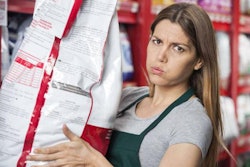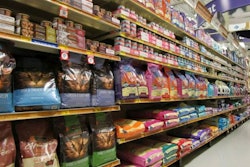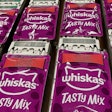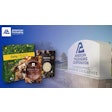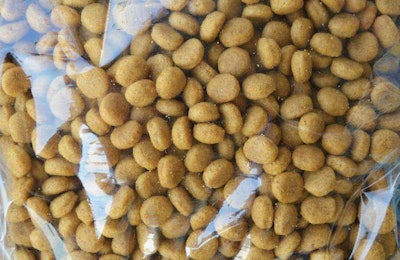
The specialty pet food market continues to expand and diversify due to increasing consumer demand. With such a fast-growing segment and increasing customer scrutiny, pet food companies are using packaging as branding to ensure they continue to stand out on the shelves.
“It’s very clear that there are trends developing in packaging, and I think pet food is far beyond a lot of other categories as far as design,” said Larine Urbina, communications manager for Tetra Pak Inc. “You’re seeing a lot of premium products have a black background, and it tells you very quickly that okay, this is a premium product. And there’s the calling out of attributes—is it non-GMO, is it organic, and so forth—and doing so with icons, instead of text. Pet food used to be kind of cartoony: Look, it’s for your pet, and here’s a silly drawing of a dog with his tongue hanging out. But now it’s going away from that; it’s not some goofy little thing. It exactly mirrors what we’re seeing in human food—cleaner, much more direct and no hiding the ingredients.”
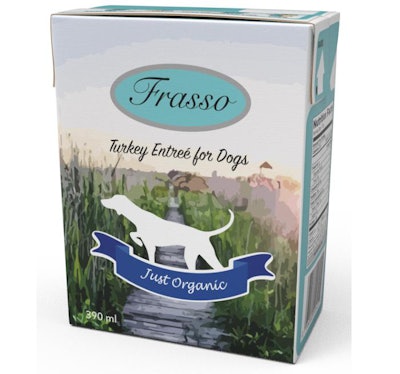
“People aren’t as brand loyal as they used to be,” said Larine Urbina, Tetra Pak communications manager. “Millennials shop based on the claim on the package and what catches their attention. They’re very open to trying new products. It’s really about standing out on a shelf and telling your story to the consumer.” | Courtesy Tetra Pak
Another trend in the visual premiumization of packaging is the “matte” look. “Matte finish is typically an overlacquer that is put over the outside of the bag,” said Kyle Knott, senior account manager for Pacific Bag Inc. (PBi). “This creates a muted effect to the graphics on the bag. A registered matte finish is the same; however, you knock out elements of the matte to bring back a ‘shiny’ appearance. This can be a great way to make your company name or logo really ‘pop’ off the bag while the background graphics lend a hand to the overall buying experience.”
Sending a visual message to pet food consumers
The desire to highlight those specific attributes—premium quality, clean labels and unique ingredient offerings—is now a driving force in re-branding campaigns, and pet food companies are naturally turning to packaging as their primary marketing vehicle.
“Given the exploding shelf presence of rehydrated food alternatives in pet specialty, we’re continuing to leverage Sojos’ easy-to-recognize and user-friendly package designs,” said Ward Johnson, Sojos co-founder. “That includes strong, clean, highly branded imagery across our product lines."
“A good example is our newly introduced Sojos Complete for Puppies and complementary Sojos SimplyPuppy treats,” said Ward Johnson. “The packaging remains true to the templates for Sojos Complete food and our raw, freeze-dried treats—but baby blue and pink colors with puppy-friendly polka dots give them a unique twist.”
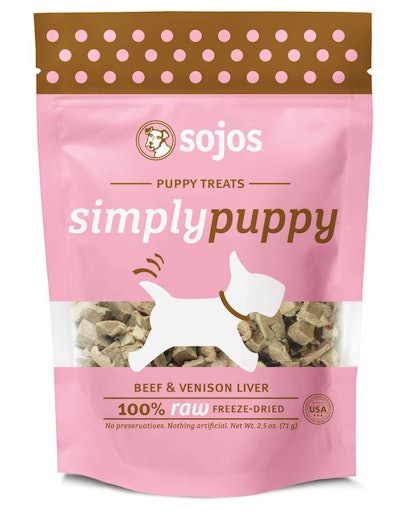
In terms of functionality, Sojos food bags feature a laser-scored tear notch and re-sealable zipper for added convenience, according to the company. The clear panel window provides an unobstructed view of the real meat, vegetables and fruit inside. And the satin "soft-touch" finished material exceeds food-grade specifications to ensure durability and freshness throughout the product’s 18-month shelf life. | Courtesy Sojos
Solid Gold introduced a significant packaging redesign in 2015, but in keeping with changing trends, they tweaked their successful rebranding for 2016’s new and existing products. “There were a lot of positive notes in that original transition, and we did make a point to intentionally keep as much of that as we could,” said Jen Berglund, Solid Gold’s director of marketing. “We didn’t want or need another drastic transition, but we wanted to take it a step further and really optimize and better set up the line for future growth as we think of adding other SKUs. You’re seeing the superfoods, which were always a part of the formulas, called out a little bit more overtly. And what we really tried to do was set up a hierarchy: what is this product, who is it for, and why would they buy it. So within the line of all these products, just really helping the consumer better understand the offerings in an effort to find the formula that’s right for their pet.”
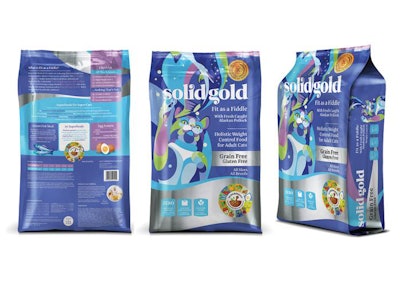
In tweaking the company’s 2015 re-design, Solid Gold decided to focus on a hierarchy of ideas: what is the product, who is it for and why would the customer buy it. | Courtesy Solid Gold
Most importantly, companies want to catch the eyes of consumers as they’re perusing the shelves that are now saturated with options. “We’re proud of the level of quality and care we put into our pet food, and now we’re excited to refresh our packaging to reflect those standards,” said Brad Gruber, chief operating officer of Health Extension Pet Care. The company has expanded its line of grain-free options and took a look at packaging in the process “We anticipate our current clients will be pleased with the design and hope to catch the eyes of new customers, as well.”
Health Extension’s new look showcases vibrant colors and real pets to effectively represent the company’s line of products, according to Gruber. Bright color schemes with warm accents and engaging fonts tie the packaging together to highlight important product and company attributes, such as grain free, family owned and made with whole food ingredients.
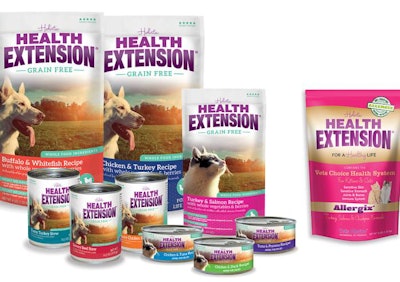
Health Extension Pet Care has refreshed its packaging to “better reflect the standards of our product and catch the eye of the next generation of pet parents,” according to the company. | Courtesy Health Extension Pet Care
Merging form and function to maximize packaging as branding
Tetra Pak’s carton packaging is finding its way into the pet food industry due to a combination of sustainability benefits, retail shelf (and pantry) convenience, ease of use and space for branding, according to the company.
“There’s nothing wrong with a pouch or a can,” said Blaine Johnson, director of business development for Tetra Pak. “But there are many more resources available now. Seventy percent of our packaging is paper. It’s a managed forestry system. For every tree we cut down, we plant three. It’s in the world’s best interests, as well as Tetra Pak’s, to manage these forestries with the proper methodology. And we do use a little bit of aluminum foil in the packaging, but it’s really thin and helps maintain product quality.”
Beyond sustainability, packaging must be convenient for the consumer, which is where rectangular or flat-bottomed packaging has a leg up. “You can completely stock your pantry with rectangular cartons,” said Urbina. “There’s no wasted space.”
It helps to create convenience for the retailer, as well. “You can get about 30% more units on the shelf just because of the modular size of [a carton] versus a can,” said Blaine Johnson. “And as a brand owner, they like it because it has a better billboard effect. A can may get turned around and a consumer in a hurry might not see it.”
Sojos introduced flat-bottom, five-sided packaging for the first time in 2016 for many of the above reasons. “The new bags not only stock and display better, they offer more real estate for clear messaging and improved readability,” said Ward Johnson. “That’s a key benefit for pet parents who are new to shelf-stable raw pet foods. The step up from kibble or canned can be intimidating—and we believe it’s incumbent on our packaging to present the case for raw in a way that’s easy to access and simple to apply.”
The block bottom bag (also referred to as “flat bottom bag”) is the next evolution in packaging, according to Knott. “Combining all of the best features of the stand-up pouch and a side gusseted bag, the block bottom bag is unique in that it gives you 360 degrees of real estate for printing your company information, logo, feeding instructions, etc.,” he said. “Whether the bag is standing up or lying flat, the block bottom bag is designed to get your product noticed at every angle. In addition, the side panels of the block bottom bag are made from a separate web of material. This means they can be made out of an entirely different substrate than the front, back and bottom of the bag. This can give you an edgy look over the traditional square or oval window on the front or back of the bag.”
The future of pet food packaging
Through consumer research, market trend analysis and a desire to stand out among the competition, pet food manufacturers are stepping up their game when it comes to packaging their products. And if the current wave of re-branding, re-packaging and specialty formulation is any indication, the industry will be looking to innovation as a significant part of their marketing strategies for some time to come.
Packaging case study: Solid Gold
At SuperZoo 2015, Solid Gold highlighted its new packaging design as part of the company’s new brand identity. “It’s always risky to redesign your brand image, but [our] old logo doesn’t effectively communicate the spirit and progressive essence of our brand,” said Michael Stoeckle, former vice president of corporate strategy for Solid Gold, at the time. “The new look is fresh and modern. It’s simple, confident, approachable and fun. It captures the intensity and fearless spirit of who we are.”
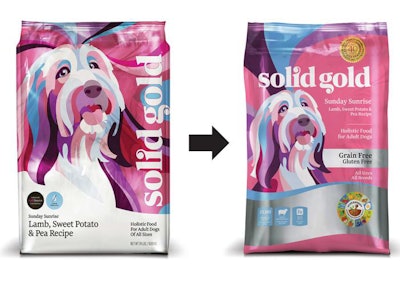
Courtesy Solid Gold
At SuperZoo 2016, Solid Gold was highlighting a new product line and optimized packaging that took the best of 2015’s redesign and combined it with retailer and customer feedback to introduce a further refined look. “What we found with this original transition is it was very clean, very pretty and we got phenomenal feedback from retailers that it popped on the shelf, so we really wanted to preserve that,” said Jen Berglund, director of marketing for Solid Gold. “But we really wanted to help the consumer be able to distinguish between the lines. As it relates to [the company’s new] high-protein line, we did do consumer research around the packaging, so that helped inform some of our choices there.”
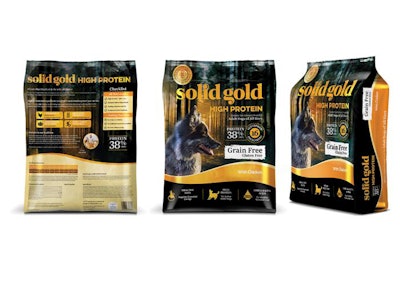
Courtesy Solid Gold


